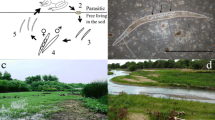Abstract
Temperature and soil moisture are the most important factors affecting the development and survival ofHaemonchus contortus andTrichostrongylus columbriformis eggs and larvae on pasture. More than half of the eggs develop into infective larvae in the laboratory, but a very low percentage (0.03% forH. contortus) does so on pasture. There is a marked difference betweenH. contortus andT. colubriformis in survival of infective larvae.H. contortus larvae survived in the winter at Urbana poorly, whereasT. colubriformis did well. The former survived better than the latter in the spring and worse in the summer, while both survived equally well in the fall. Technics for larval recovery from pasture are not very efficient. Meteorologic conditions at ground level where the larvae exist are quite different from those in a standard weather shelter 1.6 m above the ground. Bioclimatographs in which mean monthly maximum temperatures are plotted against total monthly precipitation are fairly good in predicting the type of nematode liable to be important in a given region, but they are too simplistic to be relied on for more than approximations.
Similar content being viewed by others
References
DINABURG, A.G. (1944a): The survival of the infective larvae of the common ruminant stomach worm,Haemonchus contortus, on outdoor grass plots. Amer. J. Vet. Res., 5: 32–37.
DINABURG, A.G. (1944b): Development and survival under outdoor conditions of eggs and larvae of the common ruminant stomach worm,Haemonchus contortus. J. Agr. Res., 69: 421–433.
GORDON, H.M. (1948): The epidemiology of parasitic diseases, with special reference to studies with nematode parasites of sheep. Aust. Vet. J., 24: 17–45.
GORDON, H.M. (1953): The epidemiology of helminthosis in sheep in winterrainfall regions of Australia. 1. Preliminary observations. Aust. Vet. J., 29: 337–348.
GORDON, H.M. (1967): The diagnosis of helminthosis on sheep. Vet. Med. Rev. 1967: 140–168.
HAMON, W.R. (1961): Estimating potential evapotranspiration. Proc. Amer. Soc. Civil Engrs., J. Hydraulics Div., 87, HY3, Pt. 1: 107–120.
KATES, K.C. (1950): Survival on pasture of free-living stages of some common gastrointestinal nematodes of sheep. Proc. Helm, Soc. Wash., 17: 39–58.
KATES, K.C. (1965): Ecological aspects of helminth transmission in domesticated animals. Amer. Zool., 5: 95–130.
LEVINE, N.D. (1959): Does pasture rotation control sheep parasites? Ill. Res., 1: 12–13.
LEVINE, N.D. (1963): Weather, climate, and the bionomics of ruminant nematode larvae. Adv. Vet. Sci., 8: 215–261.
LEVINE, N.D. and ANDERSEN, F.L. (1973): Development and survival ofTrichostrongylus colibriformis on pasture. J. Parasit., 59: 147–165.
LEVINE, N.D. and CLARK, D.T. (1961): The relation of weekly pasture rotation to acquisition of gastrointestinal nematodes of sheep. Ill. Vet., 4: 89–97.
LEVINE, N.D., CLARK, D.T., BRADLEY, R.E. and KANTOR, S. (1975): The relation of pasture rotation to acquisition of gastrointestinal nematodes by sheep. Amer. J. Vet. Res., (in press).
LEVINE, N.D., TODD, K.S., Jr. and BOATMAN, P.A. (1974): Development and survival ofHaemonchus contortus on pasture. Amer. J. Vet. Res., 35: 1413–1422.
LUCKER, J.T. (1941): Climate in relation to worm parasites of livestock. Climate and Man. Yearbook Agr., U.S. Dept. Agr., 517–527.
MICHEL, J.F. (1969): The epidemiology and control of some nematode infections of grazing animals. Adv. Parasit., 7: 211–282.
MITCHELL, J.K. and ANDERSEN, F.L. (1969): A computer program for meteorologic data reduction. Trans. Ill. Acad. Sci., 62: 15–28.
ROSENBERG, N.J. (1974): Microclimate: The Biological Environment. John Wiley & Sons, New York, 315 pp.
SMITH, L.P. (1974): Meteorological factors of importance in biological systems. A.E.R. Taylor and R. Muller (ed.) In: The Effects of Meteorological Factors upon Parasites. Symp. Brit. Soc. Parasit., 12: 13–32.
TETLEY, J.H. (1950): The differentiation of the eggs ofHaemonchus contortus and species of the sheep and a note on the relative generic egg-laying rates. Parasitology, 40: 273–275.
TODD, K.S., Jr., LEVINE, N.D. and ANDERSEN, F.L. (1970): An evaluation of the Baermann technic using infective larvae ofHaemonchus contortus. Proc. Helm. Soc. Wash., 37: 57–63.
TODD, K.S., Jr., LEVINE, N.D. and WHITESIDE, C.C. (1970): Moisture stress effects on survival of infectiveHaemonchus contortus larvae. J. Nematol., 2: 330–333.
U.S. DEPT. OF COMMERCE (1967–1971): Climates of the states. California, Idaho, Illinois, Maryland, Oregon, var. pag.
THOMAS, R.J. (1974): The role of climate in the epidemiology of nematode parasitism in ruminants. In: The Effects of Meteorological Factors upon Parasites. A.E.R. Taylor and R. Muller (ed.), Symp. Brit. Soc. Parasit., 12: 13–32.
Author information
Authors and Affiliations
Additional information
Supported in part by research grant AI-06197 from the National Institutes of Health.
Rights and permissions
About this article
Cite this article
Levine, N.D., Todd, K.S. Micrometeorological factors involved in development and survival of free-living stages of the sheep nematodesHaemonchus contortus andTrichostrongylus colubriformis. A review. Int J Biometeorol 19, 174–183 (1975). https://doi.org/10.1007/BF01460016
Received:
Issue Date:
DOI: https://doi.org/10.1007/BF01460016




